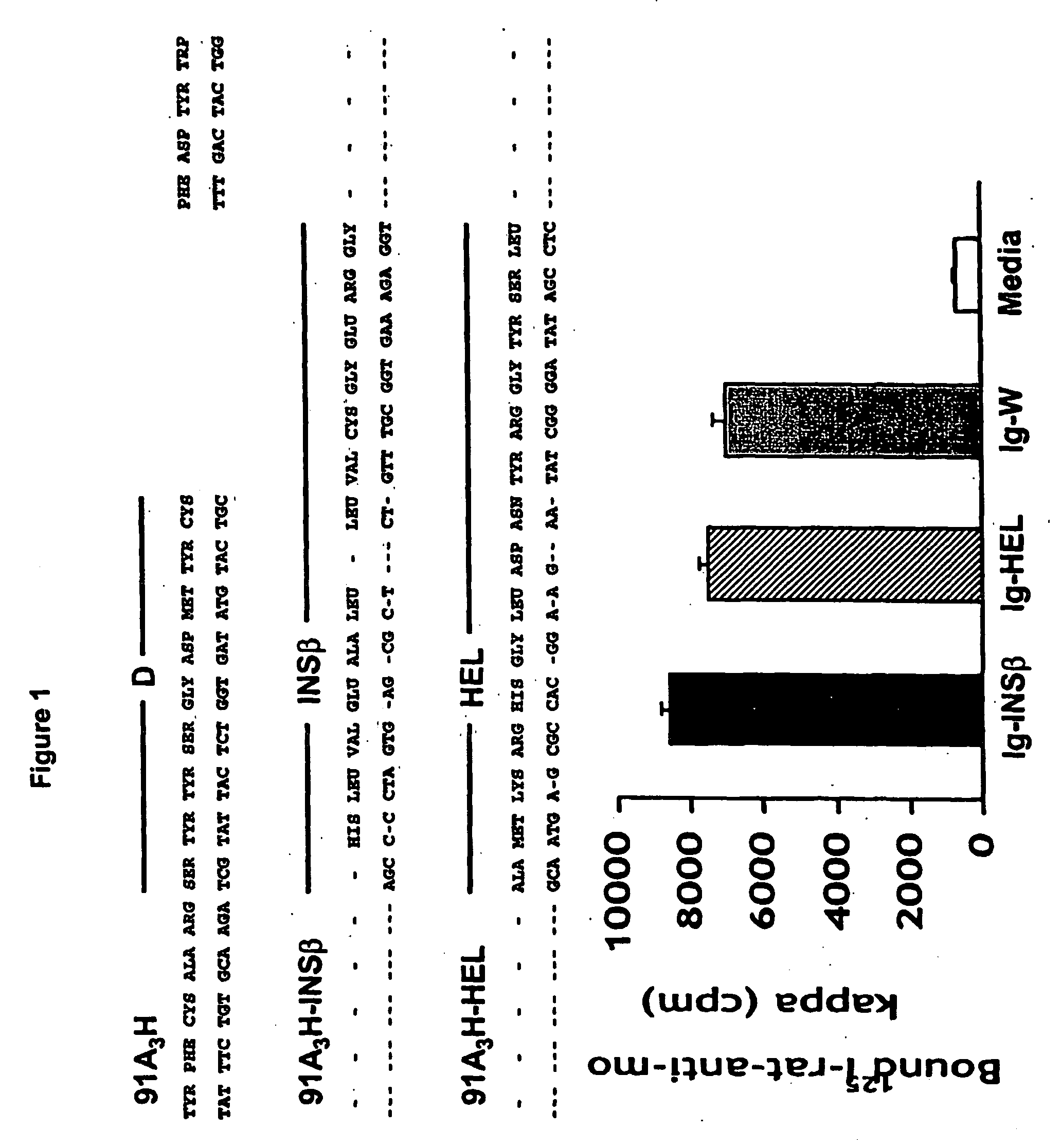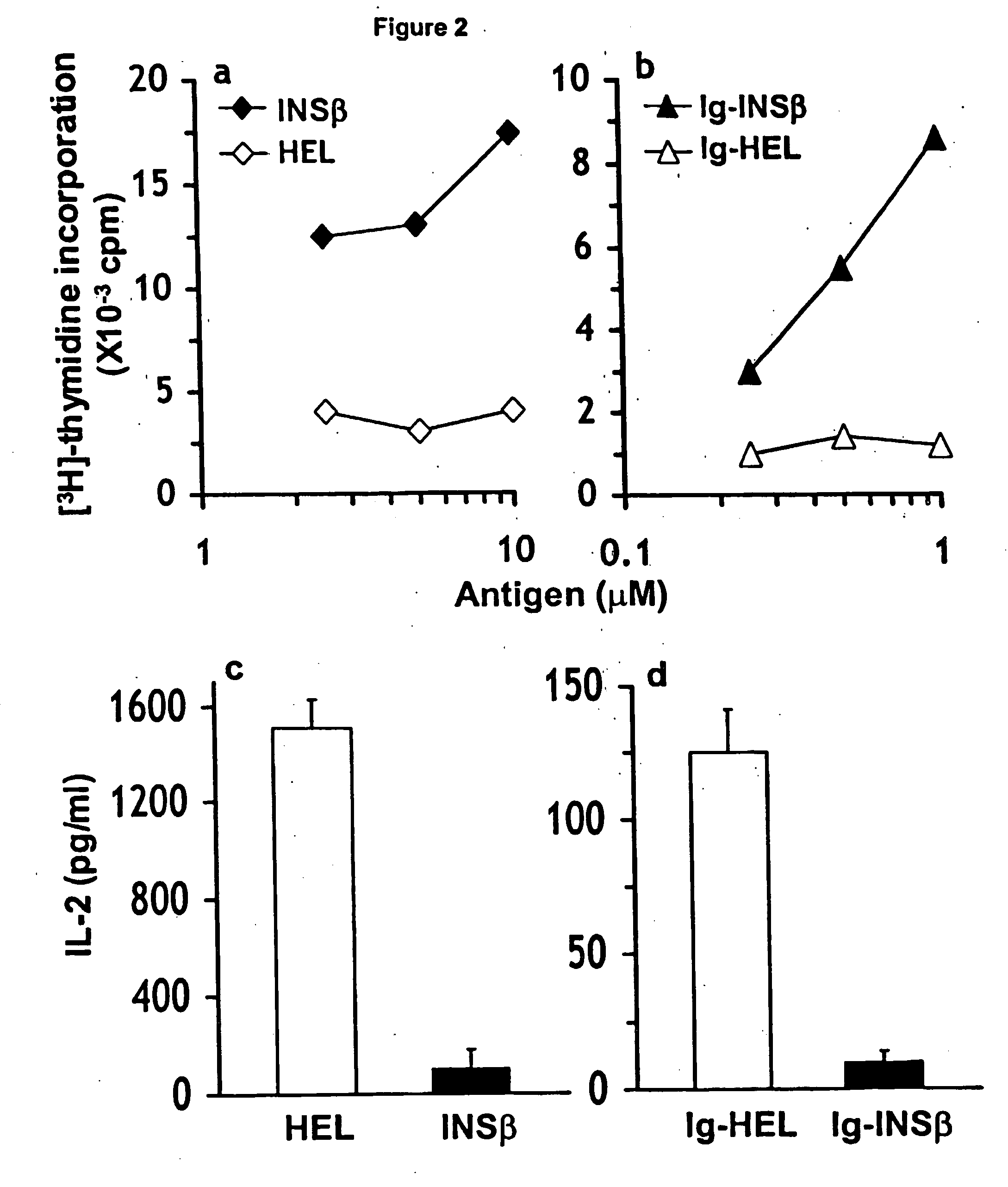Treatment of type 1 diabetes before and after expression of predisposition markers
a predisposition marker and type 1 diabetes technology, applied in the direction of drug compositions, antibody medical ingredients, metabolic disorders, etc., can solve the problems of inability to translate to humans, poor fine control of carbohydrate metabolism, and still associated side effects of chronic insulin replacement therapy, so as to prevent or reduce the risk of developing type, the effect of preventing the activation of diabetogenic t cells
- Summary
- Abstract
- Description
- Claims
- Application Information
AI Technical Summary
Benefits of technology
Problems solved by technology
Method used
Image
Examples
example 1
Expression of INSβ and HEL Peptides on Ig Molecules Drives Efficient Presentation to T Cells
[0210] Recent studies have revealed that mice with an ongoing EAE ameliorate their disease when treated with chimeric Igs expressing myelin epitopes (20, 22, 23). This investigation seeks to determine whether similar delivery of a diabetogenic peptide on Igs could inhibit IDDM in the NOD mouse. The I-Ag7-restricted INSβ peptide defined to be associated with the development of diabetes in the NOD mouse (37, 38) was selected for expression on Igs to generate an Ig-INSβ chimera suitable for evaluation against diabetes. HEL peptide, which is presented by I-Ag7 MHC class II molecules without causing diabetes (30), was used to generate an Ig-HEL chimera to serve as a control. Accordingly, INSβ and HEL nucleotide sequences were separately inserted into the CDR3 of the 91A3 heavy chain by PCR mutagenesis (18) and the resulting chimeric heavy chain genes were analyzed by DNA sequencing (see “Material...
example 2
Ig-INSβ is Processed Properly and Generates an INSβ Peptide that Could Be Presented to T Cells
[0214] The next question to address was whether Ig-INSβ is processed properly and generates an INSβ peptide that could be presented to T cells. To test this premise, the chimera was purified from the supernatant of large-scale cultures by affinity chromatography and assayed for presentation using an INSβ-specific T cell line that has been generated in NOD mice by immunization with INSβ peptide (see “Materials and Methods”). Similarly, to ensure that HEL peptide could be processed from Ig-HEL and presented to T cells, an HEL-specific hybridoma was generated by fusing the HEL-specific short-term T cell line with the αβ-T cell receptor (αβ-TCR)-negative thymoma BW1100 (see “Material and Methods”).
[0215] Presentation of Ig-INSβ chimera to specific T cells was then determined. Irradiated (3000 rads) NOD splenocytes (5×105 cells / 50 μl / well) were incubated with 100 μl antigen and one hour later ...
example 3
Insulin-Specific Autoantibodies Can Serve as a Marker for Early Development of Diabetes
[0217] Gender study of the incidence of diabetes in our NOD colony indicated that 38% of male NOD mice develop spontaneous diabetes by the age of 26 weeks. However, female NOD mice have shown a greater susceptibility for the disease and 80% developed spontaneous diabetes at week 26 of age. This is in good agreement with previous reports and suggests that the use of female mice would be more suitable for our investigation.
[0218] Recently, it has been shown that IAA can be used as a marker for prediction of type 1 diabetes in children and young NOD mice (39, 40). This is advantageous as it targets intervention prior to significant destruction of β cells without compromising the accuracy of the study. Therefore, it was decided to develop a chart to include only IAA-positive mice to assess the ability of Ig-INSβ for suppression of diabetes. Accordingly, a group of 70 NOD female mice was subject to w...
PUM
| Property | Measurement | Unit |
|---|---|---|
| concentration | aaaaa | aaaaa |
| temperature | aaaaa | aaaaa |
| pH | aaaaa | aaaaa |
Abstract
Description
Claims
Application Information
 Login to View More
Login to View More - R&D
- Intellectual Property
- Life Sciences
- Materials
- Tech Scout
- Unparalleled Data Quality
- Higher Quality Content
- 60% Fewer Hallucinations
Browse by: Latest US Patents, China's latest patents, Technical Efficacy Thesaurus, Application Domain, Technology Topic, Popular Technical Reports.
© 2025 PatSnap. All rights reserved.Legal|Privacy policy|Modern Slavery Act Transparency Statement|Sitemap|About US| Contact US: help@patsnap.com



